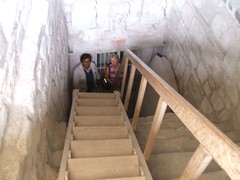Down into the Tomb! Cerro de la Campana
By rfay - Posted on May 28th, 2007
Tagged: Inuvik to Ushuaia
Our last day into Oaxaca City was a pretty easy one, so we didn't get started too early. Then about 2 miles into the ride we saw a sign that said "Santiago Suchilquitongo - Visit our tomb and museum!". Well, Santiago Suchilquitongo wasn't in our guidebook and we had no idea what to expect, but Nancy was game and we rode in.
A few questions and we found that we had to ride up a steep hill to get to the tomb. So we did. Then a few more questions and we found we had to hike up a much longer steep hill to get to the tomb. So we found a friend to watch the bikes and started up. It turned out to be a pretty good distance.
Finally up at the top was a well-preserved pyramid, which we enjoyed, but is no big deal for this area. There was nobody else at the site, except two caretakers near a covered area with a set of doors. This must be the "tomb". They explained that the tomb was closed to the public. However, a little bit into the conversation, it turned out that US$10.00 or so could open the tomb to the public, and the doors opened up and we walked down a rickety wooden staircase into a beautiful Zapotec tomb dating from about 500 A.D.
We had to lay on the floor and use flashlights to look through the barred doors and see the paintings and reliefs on the wall, and look into the tomb. It was amazing - there were paintings in red, white, and green, not just the usual little bit of red. And amazing reliefs on the wall. It was amazing to get a private little view into an ancient tomb.
We then walked back and rode into town, where the community museum was unlike anything we've ever seen in a small-town museum. You know how most little museums are - all the stuff that grandpa couldn't get rid of and the kids donated to the museum, stuck into cases. Well, not this one! It had two sides, one devoted to the tomb (with pictures that showed what it looked like when you weren't laying on the floor with a flashlight) and the other side devoted to that particular village's governance, daily life, and festivals. Wow, do I want to be there for their July 23-26 festival some year! They had glorious color photographs and excellent exposition of them all (in Spanish only). It might have been one of the few little museums we've ever been so happy to visit.
A few questions and we found that we had to ride up a steep hill to get to the tomb. So we did. Then a few more questions and we found we had to hike up a much longer steep hill to get to the tomb. So we found a friend to watch the bikes and started up. It turned out to be a pretty good distance.
Finally up at the top was a well-preserved pyramid, which we enjoyed, but is no big deal for this area. There was nobody else at the site, except two caretakers near a covered area with a set of doors. This must be the "tomb". They explained that the tomb was closed to the public. However, a little bit into the conversation, it turned out that US$10.00 or so could open the tomb to the public, and the doors opened up and we walked down a rickety wooden staircase into a beautiful Zapotec tomb dating from about 500 A.D.
We had to lay on the floor and use flashlights to look through the barred doors and see the paintings and reliefs on the wall, and look into the tomb. It was amazing - there were paintings in red, white, and green, not just the usual little bit of red. And amazing reliefs on the wall. It was amazing to get a private little view into an ancient tomb.
We then walked back and rode into town, where the community museum was unlike anything we've ever seen in a small-town museum. You know how most little museums are - all the stuff that grandpa couldn't get rid of and the kids donated to the museum, stuck into cases. Well, not this one! It had two sides, one devoted to the tomb (with pictures that showed what it looked like when you weren't laying on the floor with a flashlight) and the other side devoted to that particular village's governance, daily life, and festivals. Wow, do I want to be there for their July 23-26 festival some year! They had glorious color photographs and excellent exposition of them all (in Spanish only). It might have been one of the few little museums we've ever been so happy to visit.


